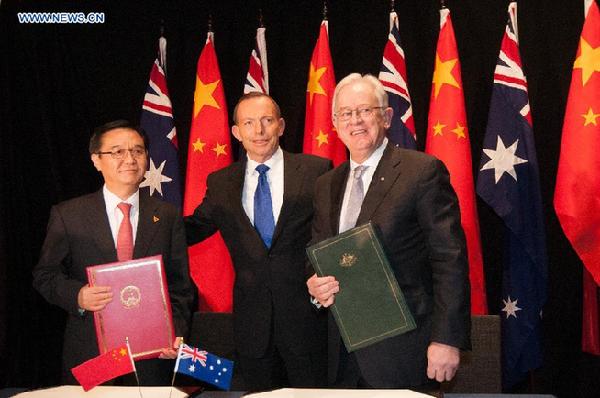China-Australia FTA supports Asia Pacific economic progress
- By Dan Steinbock
 0 Comment(s)
0 Comment(s) Print
Print E-mail China.org.cn, June 19, 2015
E-mail China.org.cn, June 19, 2015
|
|
|
China's Commerce Minister Gao Hucheng (L) and Australia's Trade Minister Andrew Robb (R) pose for photos with Australian Prime Minister Tony Abbott after signing the China-Australia Free Trade Agreement at the National Gallery in Canberra June 17, 2015. [Xinhua photo] |
After almost a decade of talks, China and Australia recently signed a Free Trade Agreement (FTA). After more than 20 rounds of talks spanning across three governments and five prime ministers, the two key negotiators, China's Commerce Minister Gao Hucheng and Australia's Minister for Trade and Investment Andrew Robb, eventually inked the deal.
To Gao, the agreement represents the highest degree of liberalization among all FTAs that China has so far signed. "[It] is going to provide us with more open, convenient and regulated institutional arrangements for our trade and investment exchanges going forward," he said. In turn, Robb believed that the FTA with China would deliver a $20 billion Australian dollar (US$ 16 billion) boost to trade by 2035.
The FTA was signed in the presence of Australian Prime Minister Tony Abbott. He said it was "history-making for both our countries. It will change our countries for the better. It will change our region for the better … change our world for the better."
Whenever an FTA is signed, trade negotiators and career politicians like to offer a narrative of mutual benefits and ultimate success. Nevertheless, the China-Australia FTA is not just any free trade agreement. It will mean great progress economically, and perhaps even more geopolitically. And it did not come easy.
The long march
The bilateral FTA talks began after a joint feasibility study under John Howard's government in Australia. After languishing for several years, even trade optimists began to have second thoughts about the prospect of a successful conclusion.
Reportedly, a breakthrough was achieved in the talks in May. Essentially, the two countries shelved controversial topics that were slowing the talks, including the treatment of Chinese SOEs in Australia and the Chinese tariff rate quotas in agricultural areas.
At the same time, Minister Robb made a strong case for the role of Australia in supporting China's transformation from an export-led and manufacturing-based economy toward services, consumption and innovation.
Pushing for greater Australian-Chinese rapprochement in economic relations, Robb also supported a review of the previous government ban on the Chinese telecom giant Huawei taking part in the national broadband network, as well as signing up to the China-proposed Asian Infrastructure Investment Bank (AIIB).
In the past, the bilateral trade has been driven mainly by China's demand for resources and energy, whereas Australia has purchased cheap Chinese manufacturing products. Under the FTA, China will gain from the progressive elimination of the 5 percent tariff imposed by Australia on Chinese electronic goods and home appliances.
In turn, over 85 percent of Australian exports will become tariff free. In addition to the abolishment of tariffs on agricultural products, tariffs on Australian resources, energy products and manufactured goods will also be removed.
Since coming into power, Abbott's government has sealed similar FTAs with Japan, and South Korea.







Go to Forum >>0 Comment(s)